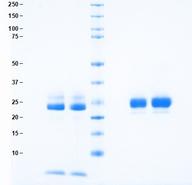
Cathepsin B
Product Sizes
0.025 mg
16-12-030102-0.025MG
0.05 mg
16-12-030102-0.05MG
1 mg
16-12-030102-1MG
About this Product
- SKU:
- 16-12-030102
- Additional Names:
- Cancer, Alzheimer's, Brain Injury, Rheumatoid Arthritis, In Vitro Diagnostics|CatB, APP secretase, APPS, CTSB
- Buffer:
- Frozen in 50 mM Na Acetate, pH 5.0, with 1 mM EDTA
- CAS Number:
- 9047-22-7
- CE/IVD:
- RUO
- Extra Details:
- Cathepsin B is a lysosomal cysteine protease synthesized as a 339-amino acid preproenzyme that matures into a heterodimer of 27.5 kDa and 5 kDa subunits linked by disulfide bonds. Its unique occluding loop structure enables dual endopeptidase and exopeptidase activities, preferentially cleaving substrates with hydrophobic or basic residues at pH 4.6 (lysosomal) versus neutral pH 7.2 (cytosolic). Beyond intracellular protein degradation, Cathepsin B modulates lysosomal biogenesis by regulating transcription factor EB (TFEB) and mechanistic target of rapamycin (mTOR) pathways, enhancing autophagy for pathogen clearance. In thyroid epithelial cells, it processes thyroglobulin to liberate thyroxine, requiring TSH-dependent secretion of mature enzyme from lysosomes. Pathologically, Cathepsin B overexpression drives cancer metastasis by degrading extracellular matrix components at tumor invasive fronts, correlating with poor prognosis in breast, lung, and cervical cancers. In Alzheimer's disease, lysosomal leakage releases Cathepsin B into the cytosol, where it cleaves tau and amyloid precursor protein, exacerbating neurofibrillary tangles and neuronal death. Traumatic brain injury models show Cathepsin B knockout reduces Bax-mediated apoptosis and motor deficits. Rheumatoid arthritis synovial fibroblasts exhibit CTSB-dependent ferroptosis, with inhibition by CA-074Me suppressing lipid ROS accumulation and migration. Therapeutically, pH-selective inhibitors like Z-Arg-Lys-AOMK (IC₅₀ = 20 nM at pH 7.2) target cytosolic Cathepsin B in neurodegeneration while sparing lysosomal function. In breast cancer, dual inhibition of Cathepsin B and Z reduces lung metastasis by 70%, highlighting synergy in protease targeting. Diagnostic applications leverage elevated serum Cathepsin B as a biomarker for sepsis severity (>45 ng/mL), COVID-19 progression, and cardiovascular risk stratification. These multifaceted roles underscore its potential as a therapeutic node across oncology, neurology, and autoimmunity.
- Formulation:
- Frozen in 50 mM Na Acetate, pH 5.0, with 1 mM EDTA
- Molecular Weight:
- 27,500 Da
- Physical State:
- Frozen
- Purity:
- ≥95%
- Purification:
- Liquid Chromatography Methods
- Shipping Conditions:
- Dry Ice
- Source:
- Prepared from liver shown to be non reactive for HBsAg, anti-HCV, anti-HBc, and negative for anti-HIV 1 & 2 by FDA-required tests.
- Storage Conditions:
- Please refer to datasheet
- Supplier:
- Athens Research & Technology Inc.
- Type:
- Proteins, Peptides, Small Molecules & Other Biomolecules: Enzymes


